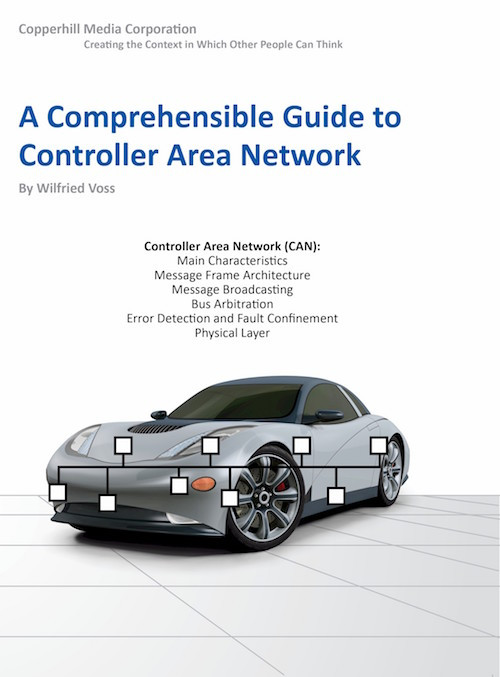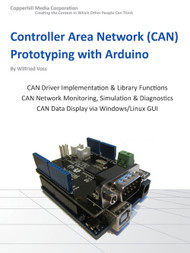- Home
- Literature
- A Comprehensible Guide to Controller Area Network
Product Description
Free Shipping Within the United States!
ISBN: 978-09765116-0-1
Printed: 146 pages, 6" x 9", perfect binding
Publisher: Copperhill Technologies Corporation
Copyright: © 2005 by Copperhill Technologies Corporation
Language: English
A Comprehensible Guide to Controller Area Network by Wilfried Voss represents the most thoroughly researched and most complete work on CAN Bus available in the marketplace. Controller Area Network (CAN) is a serial network technology that was originally designed for the automotive industry, especially for European cars, but has also become a popular bus in industrial automation as well as other applications. The CAN bus is primarily used in embedded systems, and as its name implies, is a network technology that provides fast communication among microcontrollers up to real-time requirements, eliminating the need for the much more expensive and complex technology of a Dual-Ported RAM. This book provides complete information on all CAN Bus features and aspects combined with a high level of readability.
The author, Wilfried Voss, is the President and owner of Copperhill Technologies, a company that specializes in prototyping of CAN Bus technology embedded solutions. The company is located in Greenfield, Massachusetts. Mr. Voss has worked in the CAN Bus industry since 1997 and before that was a specialist in the paper industry. He has a master's degree in electrical engineering from the University of Wuppertal in Germany.
Mr. Voss has conducted numerous seminars on CAN Bus and CANopen during various Real Time Embedded And Computing Conferences (RTECC) and ISA (Instrumentation, Systems, and Automation Society) events all over the United States and Canada.
PDF Download
 This title is also available as a PDF download at Lulu.com.
This title is also available as a PDF download at Lulu.com.
| Price | US$ 12.50 |
| Pages | 162 |
| File Format | |
| File Size | 2.42 MB |
| Required Software | Any PDF Reader, Apple Preview |
| Supported Devices | Windows PC, PocketPC, Mac OS, Linux OS, Apple iPhone, iPOD Touch, and more. |
About This Book
The main reason to write this book was the lack of good printed English literature on CAN basics, which is somewhat disconcerting considering that the technology was first officially introduced in 1986.
There are three official documents describing the CAN standard, the Bosch CAN Specification Version 2.0, the CiA CAN Specification and ISO 11898. The CiA (CAN-in-Automation) specification is a mere copy of the Bosch document, while ISO 11898-1 is an expanded copy with a more scientific approach. All these documents, more often than not, leave ample room for interpretation of the explained topics by omitting elaborating comments, examples or pictures.
It was surprising to find that some special topics, for instance, the CAN Overload Flag, the Bit Stuffing procedure, Bit Resynchronization, and more, are still insufficiently documented. Other documents did provide interesting details, but were somewhat vague on other topics or, in some rare cases, plain wrong.
Some additional works, originally written in German (due to the origination of the technology) are hurt by poor translation, which in turn has a damaging effect on the readability. There are also a vast amount of web sites that contain information on CAN, but they mostly provide only bits and pieces and, after all, they all have commercial aspects in mind.
This book intends to provide adequate information on Controller Area Network (CAN) paired with readability.
The first three chapters provide an overview of Controller Area Network that will allow the reader to understand the basics of CAN without being overwhelmed by technical details:
1. Overview
Introduces CAN, refers to the history of CAN, CAN applications.
- What is CAN?
- A Brief History of CAN...
- CAN Bus Applications...
- CAN Bus Controller Firmware...
- Higher Layer Protocols...
2. Main Characteristics
Explains in an overview the CAN message frames, bus access, message broadcasting, message priorities, data length and baud rate, bus arbitration and error handling.
3. Benefits of using CAN
Describes the various benefits such as low cost implementation, speed, reliability, error-resistance and worldwide acceptance.
The heart of this book is represented, however, by chapters 4 through 9, which provide more detailed technical insights:
4. Message Frames
Explains the detailed architecture of message frames.
- Controller Area Network (CAN Bus) - Message Frame Architecture
- Remote Frame
- Remote Frame on Recall
- Extended CAN Bus Protocol
5. Message Broadcasting
Explains the message broadcasting mechanism in a CAN network.
6. Bus Arbitration
Explains the bus arbitration principle in a CAN network.
7. Data Transfer Synchronization
Explains the data transfer synchronization mechanisms between nodes in a CAN network.
8. Error Detection and Fault Confinement
Explains how errors in a CAN network are detected, the determination of sporadic and permanent failures, the fault confinement and error recovery.
9. Physical Layer
Explains the CAN bus medium, bus topology, bus level, bus connections and bus length considerations.
Various technical information in this book is based on the International Standard ISO 11898-1 - Road vehicles – Controller area network CAN) – Part 1: Data link layer and physical signaling and Part 2: High-speed medium access unit
This book does not cover part 3 (Low-speed, fault-tolerant, medium dependent interface) or part 4 (Time-triggered communication) of the ISO 11898 CAN specification, since applications covered by this subject may only apply to automobiles. This book, besides automobile technologies, tries to include industrial automation aspects.
Higher layer protocols based on CAN, such as CANopen, DeviceNet, and SAE J1939 are mentioned briefly, but a more detailed description is not in the scope of this book.
There is a highly-recommended work on CANopen: Embedded Networking with CAN and CANopen by Olaf Pfeiffer, Andrew Ayre, and Christian Keydel.
The DeviceNet Specification, consisting of two volumes: Volume One - Common Industrial Protocol (CIP) and Volume Three- DeviceNet Adaptation of CIP, is available only for ODVA (Open DeviceNet Vendor Association) members. For further information, refer to http://www.odva.org.
The Society of Automotive Engineers (SAE) Truck and Bus Control and Communications Subcommittee has developed a family of standards concerning the design and use of devices that transmit electronic signals and control information among vehicle components. The SAE J1939 Standards Collection can be found exclusively on the Web at http://www.sae.org.
For more literature on SAE J1939 see also A Comprehensible Guide to J1939 by Wilfried Voss.
Extension to the book: CAN XL And Other Developments
- CAN-in-Automation (CiA) To Launch CAN XL During International CAN Conference...
- Quick Reference: Controller Area Network - CAN Bus - Versus Industrial Ethernet...
- SAE J1939 And The Challenging Migration From Classical CAN To CAN FD and CAN XL...
- CAN FD On A Legacy CAN Bus Network Is Not A Good Idea Due To Compatibility Issues...
- Comparison Of CAN Bus And Ethernet Features For Automotive Networking Applications...
 Loading... Please wait...
Loading... Please wait...







